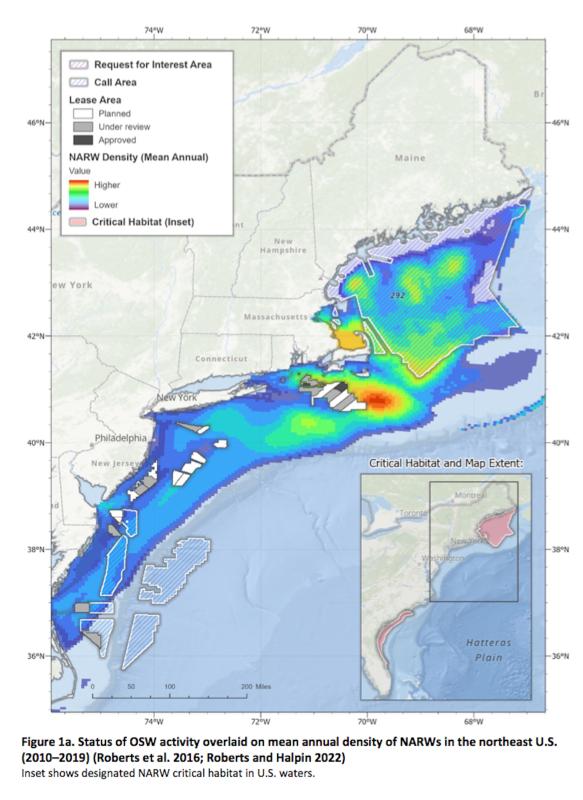Federal agencies seek comments on right whale, wind farms

Two federal agencies are inviting the public to review and comment on a draft joint strategy to protect and promote the recovery of North Atlantic right whales while responsibly developing offshore wind energy.
In an Oct. 21 press release, the Bureau of Ocean Energy Management and the National Oceanic and Atmospheric Administration’s National Marine Fisheries Service announced the release of a strategy identifying the agencies’ goals and objectives to better understand the effects of offshore wind development on the whales and their habitat. The public is invited to review and comment on the draft strategy by Sunday, Dec. 4.
The North Atlantic right whale is one of the world’s most endangered whale species; it’s been listed as endangered under the Endangered Species Act since 1970. According to NOAA, the latest preliminary estimate suggests there are fewer than 350 remaining, with fewer than 100 breeding females.
In a prepared statement, BOEM Director Amanda Lefton said the agencies are seeking open and honest feedback from the public to help evaluate and improve this effort. Working with NOAA Fisheries on this draft strategy leverages the resources and expertise of both agencies to collect and apply the best available information to inform future decisions, she said.
“This strategy provides a strong foundation to help advance renewable energy while also working to protect and recover North Atlantic right whales, and the ecosystem they depend on,” said Janet Coit, assistant administrator for NOAA Fisheries and acting assistant secretary of commerce for Oceans and Atmosphere at NOAA.
The strategy provides a clear path forward to expand upon existing efforts and to provide a long-term approach to adaptive management by integrating new information as it becomes available, said the notice. The draft strategy focuses on improving the science, and integrating past, present and future efforts related to North Atlantic right whales and offshore wind development, said the notice.
There are two offshore wind farm areas near the Delaware coastline. US Wind has the leasing rights for an area due east of Ocean City, Md. If fully developed, the project could produce 1,100 megawatts of energy, which is enough to power approximately 340,000 homes. The second lease area is due east of Delaware and its development rights are held by Ørsted. If fully developed, this project could produce 966 megawatts of energy, which is enough to power about 300,000 homes.
The maps in the strategy document confirm that US Wind’s lease area has a very low density of right whales year-round and that the closest critical habitat area is very far away, said Laurie Jodziewicz, senior director of environmental affairs for US Wind, adding the company has recently partnered with the University of Maryland’s Center for Environmental Sciences on efforts to inform responsible offshore wind development.
“Our lease is very well-sited for offshore wind for a number of reasons, including because right whales do not frequent our lease area very often,” said Jodziewicz in a statement Oct. 26.
Brady Walker, Ørsted’s head of government affairs and market strategy for Maryland and Delaware, said Ørsted shares the agencies’ common vision. The draft strategy highlights that a number of factors unrelated to offshore wind – including climate change-driven alterations to habitat – are exacerbating stress on whale populations, he said.
“Ørsted looks forward to commenting on the draft and working with the agencies and other interested parties to finalize a holistic strategy that meets these goals to protect regional biodiversity,” said Brady in a statement Nov. 1.
The announcement of the joint strategy comes after the agencies signed a memorandum of understanding outlining the intent to responsibly advance offshore wind energy development in January 2022. Following review of public comments, the strategy will be finalized, and then regularly evaluated and updated as new information becomes available.
Comments on the guidance can be submitted via regulations.gov under Docket Number BOEM-2022-0066. For more information about the draft strategy and how to submit comments, go to BOEM’s website.
Chris Flood has been working for the Cape Gazette since early 2014. He currently covers Rehoboth Beach and Henlopen Acres, but has also covered Dewey Beach and the state government. He covers environmental stories, business stories and random stories on subjects he finds interesting, and he also writes a column called Choppin’ Wood that runs every other week. He’s a graduate of the University of Maine and the Landing School of Boat Building & Design.
























































